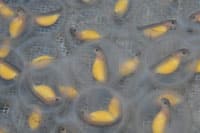Major conservation breakthrough with Cryptobranchus alleganiensis.
|
Click image to enlarge
Young hellbenders in their eggs. Note their prominent yellowish yolk sacs. Photo credit Mark Wanner/Saint Louis Zoo |
The first successful captive breeding of the Ozark hellbender (Cryptobranchus alleganiensis), has just been achieved, as part of a decade-long collaboration between the Saint Louis Zoo's Ron Goellner Center for Hellbender Conservation and the Missouri Department of Conservation. The first of these amphibians hatched on November 15, and subsequently, a further 62 offspring have emerged, increasing the surviving population by around 10 per cent!
The eggs are maintained in climate and water quality-controlled trays behind the scenes in the Zoo's Herpetarium. For 45 to 60 days after emerging, the tiny larvae will retain their yolk sac containing nutrients and move very little as they continue their development.
As the larvae continue to grow, they will develop legs and eventually lose their external gills by the time they reach 1.5 to 2 years of age. By the time they reach sexual maturity, between 5 to 8 years of age, they may be nearly two feet in length.
In the wild
Rivers in south-central Missouri and adjacent Arkansas once supported up to 8,000 Ozark hellbenders.
Today, fewer than 600 exist in the world – so few that the amphibian was added in October 2011 to the Federal Endangered Species List. Due to these drastic declines, captive propagation became a priority for the long-term recovery of the species. Once the captive-bred larvae are 3 to 8 years old, they can then be released into their natural habitat, which is the Ozark aquatic ecosystem.
Also known by the colloquial names of "snot otter" and "old lasagna sides," the adult hellbender is one of the largest species of salamanders in North America, with its closest relatives being the giant salamanders of China and Japan, which can reach 5 feet in length. With skin that is brown with black splotches, the Ozark hellbender has a slippery, flattened body that moves easily through water and can squeeze under rocks on the bottom of streams.
The canary in the coal mine
Requiring cool, clean running water, the Ozark hellbender is also an important barometer of the overall health of that ecosystem, often regarded as an aquatic "canary in a coal mine."
"Capillaries near the surface of the hellbender's skin absorb oxygen directly from the water – as well as hormones, heavy metals and pesticides," explained Jeff Ettling, Saint Louis Zoo curator of herpetology and aquatics. "If there is something in the water that is causing the hellbender population to decline, it can also be affecting the citizens who call the area home."
"We have a 15- to 20-year window to reverse this decline," added Missouri Department of Conservation Herpetologist Jeff Briggler, who cites a number of reasons for that decline, including loss of habitat, pollution, disease and illegal capture. "We don't want the animal disappearing on our watch."
Survival strategy
The Ozark Hellbender Working Group of scientists from government agencies, public universities and zoos in Missouri and Arkansas launched a number of projects in 2001 to reverse the downward trend. These included egg searches, disease sampling and behavioral studies.
By 2004, funding from private donors, the Missouri Department of Conservation, the United States Fish & Wildlife Services and the Zoo had covered the cost of building sophisticated facilities, including climate-controlled streams to breed the hellbender.
The hellbender propagation facilities include two outdoor streams that are 40 feet long and 6 feet deep. The area is landscaped with natural gravel, large rocks for hiding and artificial nest boxes, where the fertilized eggs were discovered. A nearby building houses state-of-the-art life support equipment used to filter the water and maintain the streams at the proper temperature.
In addition, two large climate-controlled rooms in the basement of the Zoo's Charles H. Hoessle Herpetarium are the headquarters for the program. The facilities recreate hellbender habitat with closely monitored temperatures, pumps to move purified water, sprinklers that mimic the exact levels of rainfall and lights that flick on or dim to account for brightness and shade.
The largest room includes a 32-foot simulated stream, complete with native gravel and large rocks for hiding. It houses a breeding group of adult Ozark hellbenders from the North Fork of the White River in Missouri; the plan is that offspring from these hellbenders will eventually be released back to boost the wild population.



